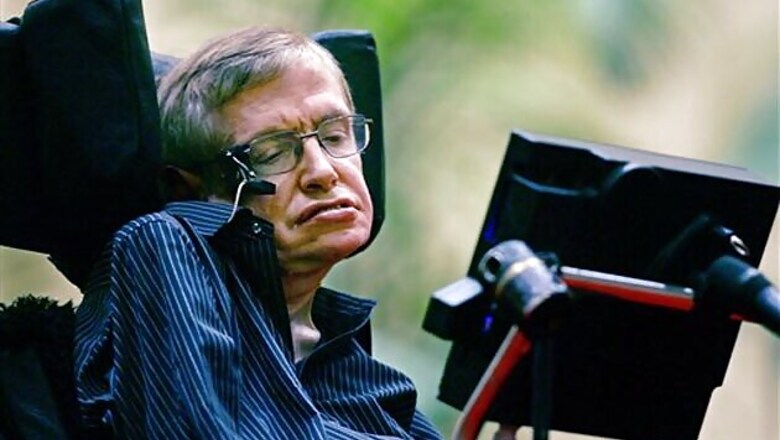
views
Geneva: Scientists at the world's biggest atom smasher hailed the discovery of "the missing cornerstone of physics" on Wednesday, cheering the apparent end of a decades-long quest for a new subatomic particle called the Higgs boson, or "God particle," which could help explain why all matter has mass and crack open a new realm of subatomic science.
First proposed as a theory in the 1960s, the maddeningly elusive Higgs had been hunted by at least two generations of physicists who believed it would help shape our understanding of how the universe began and how its most elemental pieces fit together.
As the highly technical findings were announced by two independent teams involving more than 5,000 researchers, the usually sedate corridors of the European Center for Nuclear Research, or CERN, erupted in frequent applause and standing ovations. Physicists who spent their careers in pursuit of the particle shed tears.
The new particle appears to share many of the same qualities as the one predicted by Scottish physicist Peter Higgs and others and is perhaps the biggest accomplishment at CERN since its founding in 1954 outside Geneva along the Swiss-French border.
Rolf Heuer, director of CERN, said the newly discovered particle is a boson, but he stopped just shy of claiming outright that it is the Higgs boson itself – an extremely fine distinction.
"As a layman, I think we did it," he told the elated crowd. "We have a discovery. We have observed a new particle that is consistent with a Higgs boson."
The Higgs, which until now had been purely theoretical, is regarded as key to understanding why matter has mass, which combines with gravity to give all objects weight.
The idea is much like gravity and Isaac Newton's early theories. Gravity was there all the time before Newton explained it. The Higgs boson was believed to be there, too. And now that scientists have actually seen something much like it, they can put that knowledge to further use.
The center's atom smasher, the $10 billion Large Hadron Collider, sends protons whizzing around a circular 27-kilometer underground tunnel at nearly the speed of light to create high-energy collisions. The aftermath of those impacts can offer clues about dark matter, antimatter and the creation of the universe, which many theorise occurred in a massive explosion known as the Big Bang.
Most of the particles that result from the collisions exist for only the smallest fractions of a second. But finding a Higgs-like boson was one of the biggest challenges in physics: Out of some 500 trillion collisions, just several dozen produced "events" with significant data, said Joe Incandela of the University of California at Santa Barbara, leader of the team known as CMS, with 2,100 scientists.
Each of the teams confirmed on Wednesday that they had "observed" a new subatomic particle – a boson. Heuer said the discovery was "most probably a Higgs boson, but we have to find out what kind of Higgs boson it is." He referred to the discovery as a missing cornerstone of science.
As the leaders of the two teams presented their evidence, applause punctuated their talks.
"Thanks, nature!" joked Fabiola Gianotti, the Italian physicist who heads the team called ATLAS, with 3,000 scientists, drawing laughter from the crowd.
Later, she told reporters that the standard model of physics is still incomplete because "the dream is to find an ultimate theory that explains everything. We are far from that."
Incandela said it was too soon to say definitively whether the particle was exactly the same as envisioned by Higgs and others, who proposed the existence of an energy field where all particles interact with a key particle, the Higgs boson.
Higgs, who was invited to be in the audience, said Wednesday's discovery appears to be close to what he predicted.
"It is an incredible thing that it has happened in my lifetime," he said, calling the discovery a huge achievement for the proton-smashing collider.
Outside CERN, the announcement seemed to ricochet around the world with some of the speed and energy of the particle itself.
In an interview with the BBC, the world's most famous physicist, Stephen Hawking, said Higgs deserved the Nobel Prize. Hawking said he had placed a wager with another scientist that the Higgs boson would never be found.
"It seems I have just lost $100," he said.
Marc Sher, a professor of physics at William & Mary College, said most observers concluded in December that the Higgs boson would soon be discovered, but he was "still somewhat stunned by the results."
The phrase "God particle" was coined by Nobel Prize-winning physicist Leon Lederman, but it's used mostly by laymen as an easier way of explaining the theory.
Wednesday's celebration was mainly for researchers who explore the deepest, most esoteric levels of particle science. But the particle-hunting effort has paid off in other ways for non-scientists, including contributing to the development of the World Wide Web.
CERN scientists used the early Web to exchange information, and the vast computing power needed to crunch all of the data produced by the atom smasher also boosted development of cloud computing, which is now making its way into mainstream services.
Advances in solar energy, medical imaging and proton therapy used in the fight against cancer have also resulted from the work of particle physicists at CERN and elsewhere.
The last undiscovered piece of the standard model of physics could be a variant of the Higgs that was predicted or something else that entirely changes the way scientists think about how matter is formed, Incandela said.
"This boson is a very profound thing we have found," he said. "We're reaching into the fabric of the universe in a way we never have done before. We've kind of completed one particle's story. ... Now we're way out on the edge of exploration."
The discovery is so fundamental to the laws of nature, Incandela said, that it could spawn a new era of technology and development in the same way that Newton's laws of gravity led to basic equations of mechanics that made the industrial revolution possible.
"This is so far out on a limb, I have no idea where it will be applied," he added. "We're talking about something we have no idea what the implications are and may not be directly applied for centuries."


















Comments
0 comment